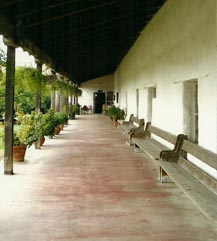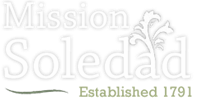About Mission Soledad
La Mision de Maria Santisima Nuestra Senora de la Soledad (Mary Most Holy, Our Most Sorrowful Lady of Solitude) was founded by Father Fermin Lasuen on October 9th, 1791 near the site of an Esselen village named Chuttusgelis. The Esselen were the original inhabitants of the valley. The mission was built to link Mission San Antonio and Mission Carmel so that the distance between the missions would be shortened. The buildings at Mission Soledad were constructed of adobe brick. The adobe brick was made by mixing dirt with water and some type of binding agent (usually straw). The mixture was then poured into forms and dried in the sun.
Father Payeras, Father Jayme, Father Ibañez and Father Sarria were four of the padres who provided the most dedication and time to the Soledad Mission. They kept the records and organized the growth. The winds could be brutal and the weather bitterly cold. When the padres needed relief from rheumatism they would go to Paraiso Hot Springs for the mineral baths. They learned of the medicinal value of the mineral baths from the Esselen who lived in this area.
By 1810 the quadrangle was completed and included a chapel, a church, four granaries, offices, a mill, a cheese factory, a hen house, a tallow factory, a kitchen, guest rooms, unmarried women’s quarters, two warehouses, a carpenter’s shop and quarters, a guard house, a corporal’s quarters, a forge, a soap factory, an apothecary, a tannery, tile kilns, a privy, a pantry, a grist mill, a lavenderia, a weavery, and possibly a fulling tank for wool production. There were quarters for the padres. There was a shoemaker. There was a vineyard with five thousand vines and an orchard. A fifteen mile aqueduct brought water to the mission from the Arroyo Seco River. Neophyte housing was built in the form of three long adobe buildings which had twenty-six rooms. It appears that the Soledad Mission specialized in wool production and weaving. At one time there were over five thousand sheep grazing the lands surrounding the mission as well as over six hundred horses and six thousand head of cattle. The mission owned three ranches: San Lorenzo, San Vicente and San Fernando.
Most of Mission Soledad was destroyed by three large floods in 1824, 1828, and 1832 which irreparably damaged the buildings. As Mission Soledad was secularized and neglected the buildings were further destroyed. In 1845, interim Governor Pio Pico sold the mission to Feliciano Soberanes for eight hundred dollars. Eventually, the mission was abandoned and fell further into disrepair. Modern ranching and farming practices helped with the decline.
Today, Mission Soledad is composed of the reconstructed South Wing and Chapel, ruinous original walls, the marked graves of Governor Arrillaga and Father Ibañez and the historic views which surround the site. The site is currently undergoing a large master planning project to reconstruct and restore significant quadrangle buildings along with overall site improvements.
For additional reading about the mission and people who lived and frequented the site be sure to look up Old Gabriel, the oldest known Native American, Charlie Parkhust, the stagecoach driver, or Bouchard, a French privateer.
Local authors have written many works, both fictional and nonfictional, about the history of this area.
Some are:
It Happened in Soledad – Mary Beth Orser
The Salinas Upside Down River – Anne B. Fisher & Betty War Brusa
A Stranger Came to the Lucias – Beatrice Casey
The Esselen Indians – Gary Breschini & Trudy Haversat
There is much information to be found in books and on the internet about the history of the Soledad Mission and the timeline of its growth. We wanted to share with you a vision of what it once was and could be again.

Key Facts
Founding Father President:
Fr. Fermin Francisco de Lasuen
Founding Missionaries:
Frs. Mariano Rubi and Diego Garcia
Indians Joining This Mission:
The Esselen were the original inhabitants of the entire area. Additional Native Americans were recruited from many tribes such as the Chalon, Yokuts, and Salinan.
Mission Layout:
A courtyard-centered quadrangle with out-buildings. Neophyte housing was located to the south and the cemetery to the east.
Population:
The highest recorded population was 687, in 1804.
Water Source:
The Salinas River (too low for irrigation) was used for livestock needs. The Arroyo Seco brought seasonal waters. A 15-mile-long aqueduct dug by neophytes (rediscovered by archaeologists from CSUMB in 2007) eventually irrigated some 20,000 acres in the Llano del Rey or lands about the mission.
Make A Donation
If you would like to be a part of the rebirth of the Soledad Mission, any donation would be appreciated and would go directly towards archaeology, architectural planning, or actual reconstruction.
